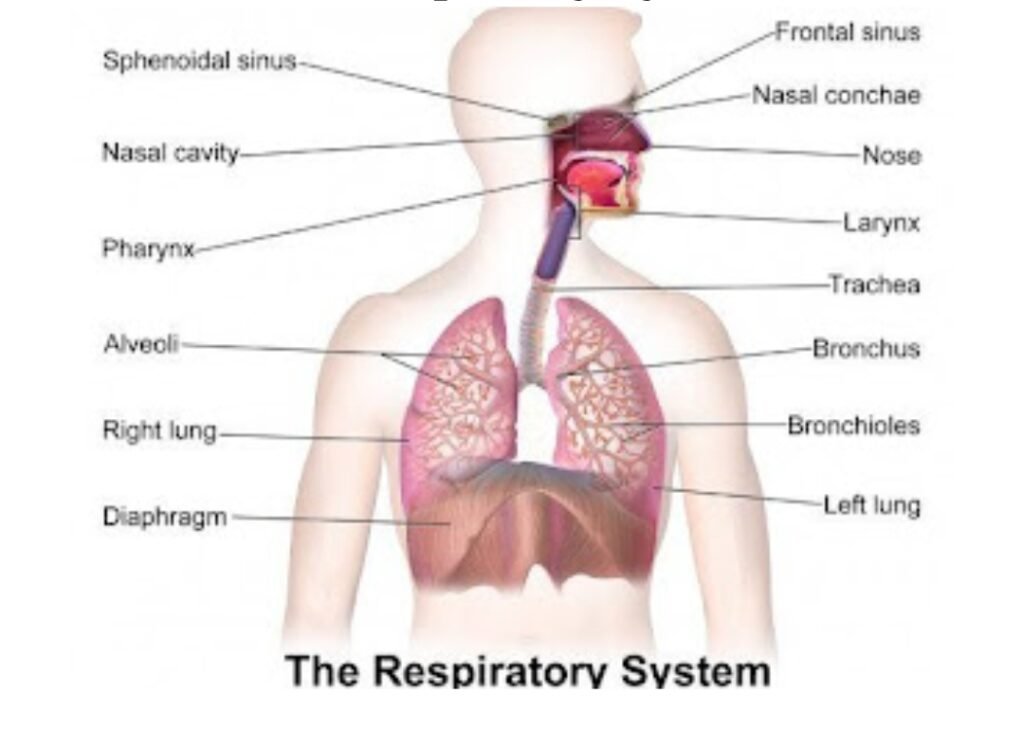The human respiratory system is a complex and vital organ system responsible for the exchange of gases between the body and the environment. Comprising a network of organs and structures, this system ensures the intake of oxygen and the expulsion of carbon dioxide, supporting cellular respiration and maintaining the body’s acid-base balance. In this comprehensive exploration, we will delve into the anatomy, physiology, and functions of the human respiratory system.
Anatomy of the Respiratory System:
1. Nasal Cavity:
The respiratory process begins with the nose, where air is initially filtered, humidified, and warmed. The nasal cavity is lined with mucous membranes and tiny hair-like structures called cilia, which trap dust and particles.
2. Pharynx:
It is divided into three parts: nasopharynx (upper), oropharynx (middle), and laryngopharynx (lower).
3. Larynx:
Commonly known as the voice box, the larynx houses the vocal cords and is crucial for speech. It also acts as a protective mechanism, preventing food and liquids from entering the trachea during swallowing.
4. Trachea:
The trachea, or windpipe, is a tubular structure made of cartilage rings. It connects the larynx to the bronchi and provides a rigid pathway for air to pass into the lungs.
5. Bronchial Tree:
The trachea branches into the bronchi, which further divide into bronchioles. This branching structure resembles an inverted tree and facilitates the distribution of air into the lungs.
6. Lungs:
The lungs are surrounded by a double-layered membrane called the pleura, which reduces friction during breathing.
7. Alveoli:
At the terminal ends of the bronchioles are tiny air sacs called alveoli. These microscopic structures are the sites of gas exchange, where oxygen from the air diffuses into the bloodstream, and carbon dioxide is released for exhalation.
Physiology of Respiration:
1. Pulmonary Ventilation:
This process is driven by the contraction and relaxation of the diaphragm and intercostal muscles, creating changes in thoracic volume.
2. Gas Exchange:
Gas exchange occurs in the alveoli, where oxygen from the inhaled air crosses the alveolar membrane and binds to hemoglobin in red blood cells. Simultaneously, carbon dioxide, a waste product of cellular respiration, diffuses from the blood into the alveoli to be exhaled.
3. Transport of Gases:
Oxygen is transported through the bloodstream bound to hemoglobin in red blood cells. Carbon dioxide, primarily transported in the form of bicarbonate ions, is carried back to the lungs for exhalation.
4. Regulation of Respiration:
The respiratory center in the brain, specifically the medulla oblongata and pons, regulates the rate and depth of breathing. Factors such as blood pH, carbon dioxide levels, and oxygen levels influence this regulatory process.
Disorders and Diseases:
1. Chronic Obstructive Pulmonary Disease (COPD):
COPD encompasses conditions like chronic bronchitis and emphysema, characterized by airflow obstruction and difficulty breathing. Smoking is a major risk factor for COPD.
2. Asthma:
Asthma is a chronic respiratory condition marked by inflammation and constriction of the airways, leading to wheezing, coughing, and shortness of breath. It often has allergic triggers.
3. Pneumonia:
Pneumonia is an infection of the lung tissue, causing inflammation and fluid accumulation in the alveoli. It can be bacterial, viral, or fungal in origin.
4. Lung Cancer:
It is strongly associated with tobacco smoking but can also be influenced by other environmental factors.
Importance of Respiratory Health:
A healthy respiratory system is crucial for overall well-being. Adequate oxygen intake supports cellular functions, energy production, and the elimination of metabolic waste. Additionally, proper ventilation helps maintain acid-base balance in the body, ensuring optimal physiological functioning.
Lifestyle Factors Affecting Respiratory Health:
1. Smoking:
Tobacco smoke contains harmful chemicals that can damage the respiratory system, leading to conditions such as lung cancer and COPD.
2. Air Quality:
Exposure to pollutants, allergens, and poor air quality can contribute to respiratory problems. Indoor pollutants, such as mold and dust, also play a role.
3. Exercise:
Regular physical activity improves lung function and overall respiratory health. It enhances the efficiency of oxygen exchange and strengthens respiratory muscles.
4. Hydration:
Maintaining adequate hydration is essential for the mucous membranes in the respiratory tract. It helps in the production of mucus, which traps and eliminates foreign particles.
Future Trends in Respiratory Health:
Advancements in medical technology continue to shape the future of respiratory health. Innovations in imaging techniques, such as high-resolution CT scans, allow for earlier detection of respiratory conditions. Additionally, research into personalized medicine and gene therapy holds promise for targeted treatments for respiratory disorders.
In conclusion, the human respiratory system is a marvel of biological engineering, playing a pivotal role in sustaining life. Understanding its anatomy, physiology, and the factors influencing respiratory health is essential for promoting well-being and preventing respiratory disorders. As scientific knowledge and medical technology progress, the future holds exciting possibilities for further improving respiratory care and treatment modalities.

